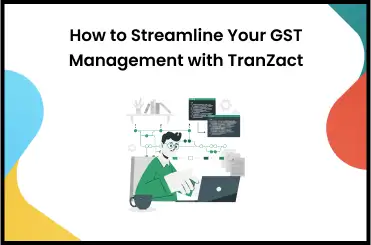GSTR 9 is an annual return form that registered businesses or taxpaying entities must file. This ensures that businesses that are registered under GST comply with its rules and regulations. The form contains all the details of information about the inward and outward supplies of the business along with specific details about income tax. All these details have to be submitted by the taxpayer while filing GSTR 9.
However, it is important to know the details of preparing for filing the GSTR 9 so that there is no confusion when you do so on the GST portal. In this ultimate guide on filing GSTR 9 form, we have covered all the details like what is GSTR 9, who should file GSTR 9, how to file GSTR 9 annual return as well as the penalties involved.
What Is GSTR-9?
The GSTR 9 form is an annual tax return form that needs to be filled by all regular taxpaying entities who are registered under GST once a year including (Special Economic Zone) SEZ units as well as SEZ developers.
Businesses make purchases and sales under various tax heads during the whole year and the GSTR 9 form contains all these details along with the turnover, audit results, and some additional information. The basic details that the taxpayer needs to put on the form are:
- Supplies that the business has made during the year.
- Supplies that the business received during the year.
- GST payable.
- Input Tax Credit (ITC) claimed the previous year.
Who Should File GSTR 9?
As we have already said that all registered taxpayers must file GSTR 9 yearly but there are several other criteria too when it comes to filing the GSTR-9 form. Let's have a look at all of them.
- The taxpayer must be registered under GST and hold a 15-digit PAN-based GSTIN.
- The annual turnover of their business must be higher than Rs. 20 lakhs to file GSTR 9.
- You also need to furnish the form with all the relevant documents and for that, you need to collect copies of all your transactions or invoices that include inter as well as intra-state trades, B2B and B2C transactions, exempted items related transactions, non-GST supplies and stock transfers to various locations that your business has done.
However, there are some exceptions, and here is a list of persons who don't need to file GSTR 9:
- Taxpayers under the Composition Scheme
- Casual Taxable Persons
- Non-resident taxable persons
- Input Service Distributors
- Persons who pay TDS
How to File GSTR-9 Annual Return?
Filing GSTR-9
Before you file GSTR-9, you must have already filed GSTR-1 and GSTR-3B as GSTR-9 is a compilation of data filed in GSTR-1 and GSTR-3B. If you want to know how to file GSTR 9, here are the steps below:
- First, you need to log in to the online GST portal using your login credentials.
- After that, click on 'Service' and navigate to the 'Return' section, where you need to choose the 'Annual Returns' section.
OR
You can also choose the Annual Return link given on the dashboard. 3. In this section, you will be able to select the relevant financial year. Select the year you are filing the GSTR 9 for, and click Search. 4. An important message related to the return will appear. Read it carefully. You can also see the due date on this page. 5. After that, click on the 'Prepare Online' tab. 6. An important message will appear, listing all the steps to be followed after clicking Prepare Online. 7. Steps for NIL Return or Actual GSTR 9 Return:
7A - For filing NIL GSTR 9, select the questionnaire page, and click the Yes radio button.
- Next, fill in the various tables and click Compute Liabilities. A preview facility is available.
- Once done, click Proceed to File and File GSTR-9 with DSC/EVC.
- In case there are any other liabilities, that can be paid via Form GST DRC-03
OR
7B. If you don't need to file a NIL return, select No for option 1 and proceed to file a GSTR-9 return. 8. Click the NEXT button. 9. You will now see the GSTR-9 Annual Return for Normal Taxpayers page. An important message listing "Steps to prepare GSTR-9 return online" will appear. Read and follow carefully. 10. You will need to download four documents to fill in the various sections of the GSTR-9 form. They include the GSTR-1 summary, GSTR-9 system computed summary, GSTR-3B summary, and Table-8A document details. 11. Fill in the required details in various tables for the financial year. 12. Click Compute Liabilities to know if there are any other pending dues or late fees. You can make the payment from the funds you have in the electronic cash ledger or via Netbanking or via NEFT/ RTGS by creating an additional payment challan. Unless previous dues and late fee if any is paid, you cannot file your GSTR-9 return. 13. After filling in the form, you can click the 'Preview Button' to view the summary of the form and the details you have entered. 14. If you want to download the GSTR 9 form, go for the tab 'Preview Draft GSTR 9 (PDF)'. 15. Finally, check the declaration box that appeared on the screen and check the authorized signatory and click on 'File GSTR 9'.
GSTR-9 Form Details
When it comes to gaining knowledge on how to file the GSTR-9 form, it is important to know that the GSTR 9 form has 6 different parts or sections that you need to fill up. Read the next section to find out how to fill in all the parts-
Part 1: Basic Details:
In this first part, you need to put your basic details, such as the legal name, trade name if you have any, financial year, and GSTIN.
Part 2: Outward and Inward Supply Details During the Financial Year:
This part asks about all the transaction details and is divided into two sections. Section-4 is for the information about advances, purchases, and supplies sales that are taxable. Section-5 is for supplies sales that are non-taxable.
Part-3: ITC Details as Declared in Return Files of the Financial Year:
The third part of the GSTR 9 has three sections, such as section-6, 7, and 8. In section-6, you need to submit details about ITC you have availed in the central, state, integral tax, and the cess value. Section-7 asks for reversed ITC and ineligible ITC. And, section-8 is for other ITC-related information.
Part 4: Details of Tax Paid During the Financial Year:
Here in this part, you need to provide the details of the tax that you paid during the financial year that you have declared in the return files.
Part 5: Transaction Particulars of the Previous Financial Year:
This part of GSTR 9 requires mentioning the particulars of the transactions of the last financial year that you have declared in the return files from April to September of the current financial year. Or you can enter the details up to the date of filing the annual returns of the previous year if it is the earlier case. You put these details under section 10.
Part-6: Other Information:
In the last part, you have to provide the details that you didn't provide before such as returns, demands, special kinds of supplies if any, HSNs, and late fees under section-16, 17, 18, and 19.
Implications and Penalties for Not Filing GSTR
Penalties are imposed on registered taxpayers if they don't file a GST return. In case of not filing GSTR 9 or late filing, the penalty charge is Rs. 100 per day per act from the due date.
If you are a registered taxpayer but haven't submitted GSTR 9 even after your due date to submit the form is over, you will be charged Rs 100 for the central GST return along with another Rs 100 for the state GST return. So, the total amount of the late fee will be Rs. 200. Moreover, it will be added with each day until you don't file the GSTR 9 form. The fee amount is fixed by the amendment of GST laws such as the State Goods and Services Act, 2017 or Union Territory Goods and Services Act, 2017, and Central Goods and Services Act, 2017.
However, you should also know that the highest limit of the total amount of penalty charge for filing GSTR 9 late is 0.25% of the total turnover. It will not go above 0.25%.
So, it is always better to file the return on time. The benefits you earn for filing GSTR 9 on or before the due date can be huge for the business. Know how-
Benefits of Filing GSTR 9 on Time
Maintain a Good Compliance Status for Lending Activities
Often lending institutions ask for annual tax reports from the borrowers as a declaration of good compliance maintenance. Timely submission of the GSTR 9 proves that your company complies with the rules and regulations of the government regarding GST and builds trust.
Avoid Getting GST Notices
Not filing GSTR 9 on time can lead to receiving potential GST notices and even the taxpayer can be called for an inquiry and scrutiny by the authority. Filing the form will help you avoid such legal proceedings.
Helps Avoiding Penalty Charges
As you know that a late filing of GSTR 9 or not filing it will end up charging a lot of amounts as a penalty, you can avoid paying such unnecessary money by timely submission of the form which will save your business from financial losses.
Improves Your Compliance Score
Compliance score is vital for making goodwill in the market which helps in better business opportunities, more deals, and sales. Submission of GSTR 9 within time each year helps improve the compliance scores for your business.
Stay GST-Compliant With TranZact
TranZact is a cloud-based platform that helps SME businesses to manage their business functions flawlessly. It will help you with invoicing and GST documentation along with inventory management, production management, and manufacturing processes. Whether it is GST invoicing, e-way billing, or filing GSTR-9, TranZact can do it all!
FAQs on How to File GSTR 9
1. What is a refund under GST?
GST refund is a process by which a registered taxpayer claims for the extra amount of tax he has already paid over his GST liability.
2. What are the forms under the GST Refund Process?
The forms under the GST refund process are GST RFD - 01, GST RFD - 02, and GST RFD - 03.
3. What documents are required for a GST refund?
The following documents are required for a GST refund:
- Income tax-related documents
- Interest or any other payments
- Copy of proof of tax deposited with invoices
- Export related documents
4. How to file GSTR-9C and what is the penalty for late filing of GSTR-9?
To file GSTR-9C you need to obtain all the relevant documents such as the audited financial statements, GSTR-9, GSTR-9A, and other relevant records. The penalty charge for GSTR 9 late filing is Rs. 100 per day per act from the due date. Therefore, it is important to know how to file GSTR 9 and how to file GSTR 9-C.
5. What is the difference between GSTR - 9 and GSTR - 9C?
GSTR 9 is the annual tax return that every registered taxpayer must submit each year irrespective of their annual turnover. However, GSTR 9C filing is done by taxpayers whose annual aggregate turnover is over Rs. 5 crores.
















